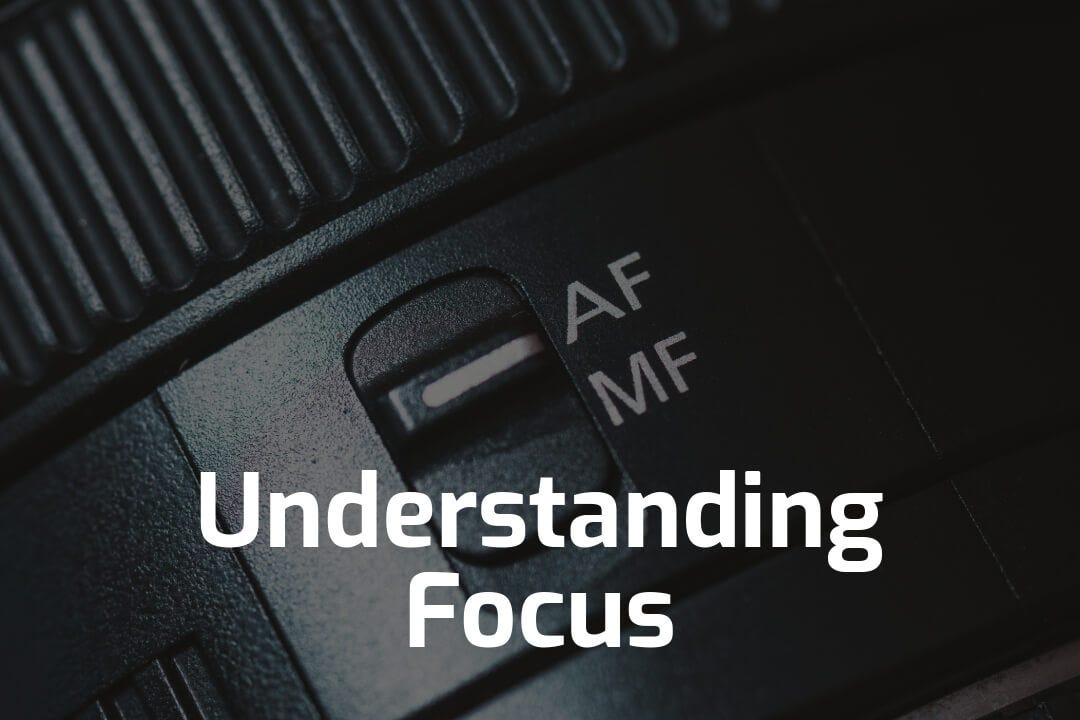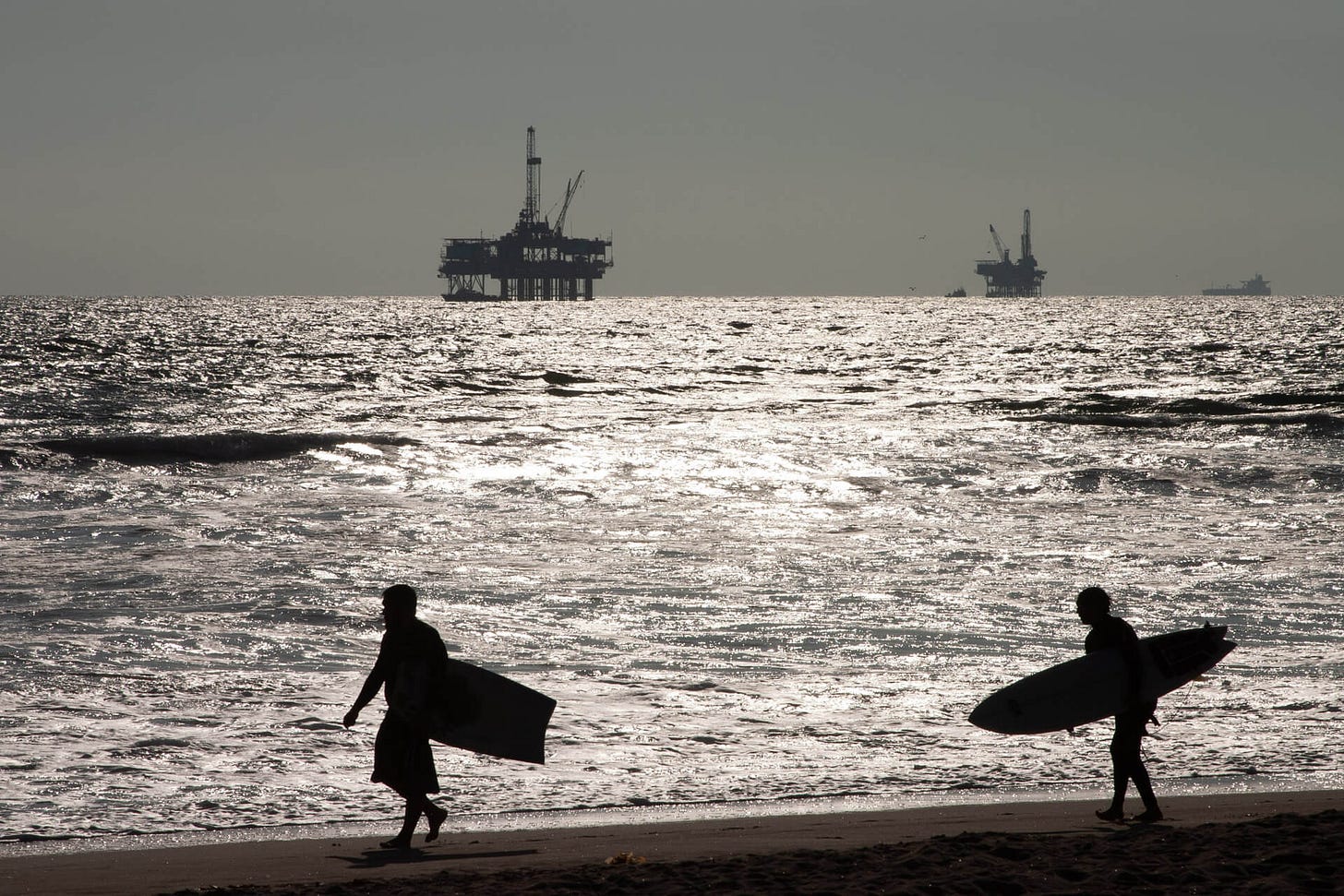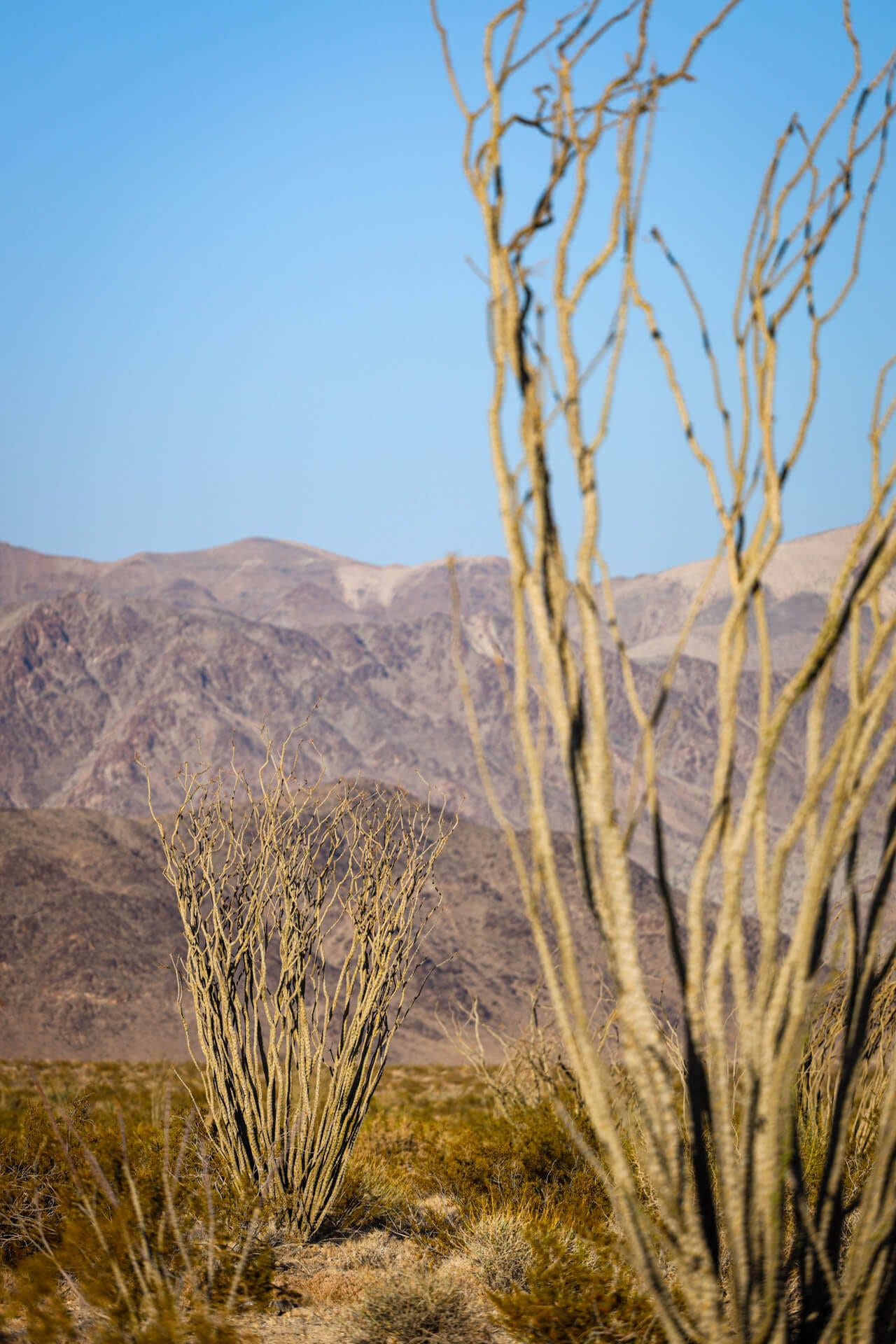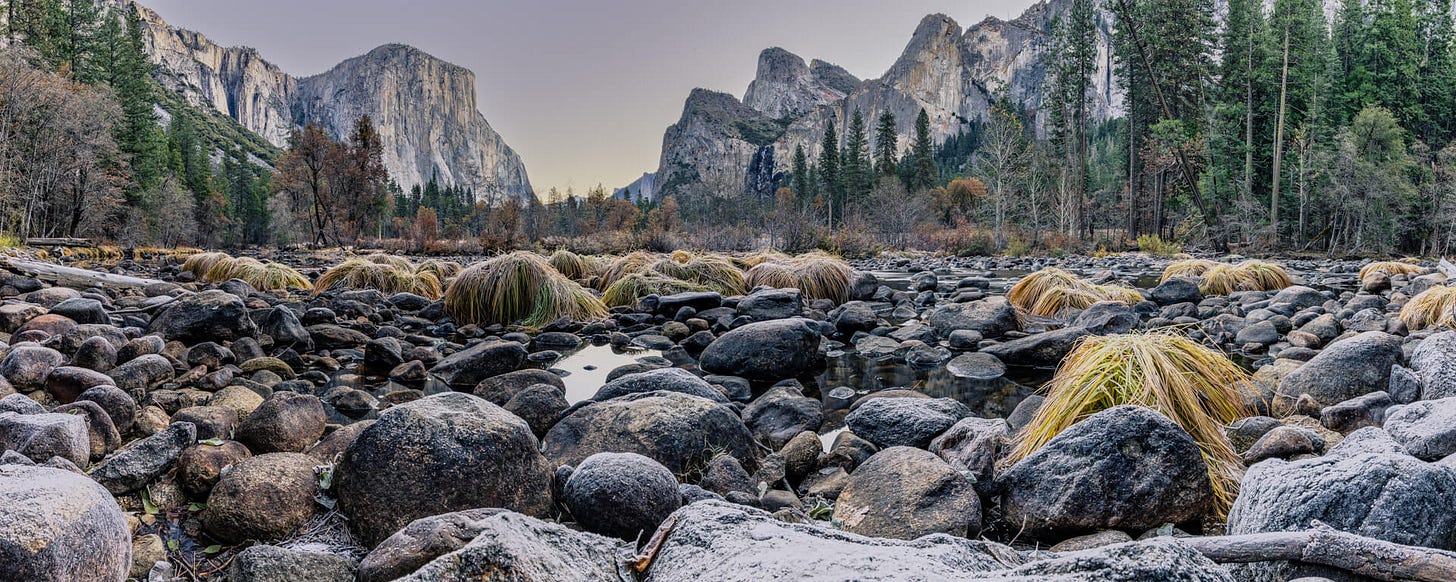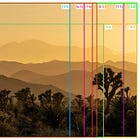Understanding Focus
Explore Landscapes #47: Where you focus in a scene you want to photograph depends on what image you want to create. What's your artistic intent? What should you consider when focusing?
If you‘re new here, welcome. I’m a professional landscape photographer and hiking/backpacking guide specializing in Joshua Tree National Park. My weekly Monday newsletter is typically a long-form ‘teaching’ article for paid subscribers and workshop attendees. My free Thursday newsletter should interest a wider audience and is typically about my hiking, volunteering, or workshop adventures.
Please subscribe to read more of my posts, visit my website to view my images, or book a workshop or mentoring session. If you value what I provide, consider becoming a paid subscriber or buying me a coffee instead. I look forward to helping you improve your photography!
What’s Focus?
When you take a photo, a sharp plane of focus (a region in space) appears within the image. Depending on your lens settings (aperture and focal length) and how far away from your subject you are, some of your image's elements may fall outside this plane of focus and appear blurry (i.e., out of focus).
This plane of focus will be somewhere between the scene's foreground and background. That 'sharp' region in space is said to be 'in focus.'
This post is a bit on the long side, and Substack is telling me it may get truncated when delivered to your email inbox. If so, please click ‘View in browser’ at the top right of the email.
In a DSLR or Mirrorless camera, focusing takes place within the lens. As the glass elements within the lens are moved closer together (or further apart), changing the optical path of the light, the position of the plane of focus in the image changes. This allows the photographer to 'pull' the plane of focus towards the camera (to focus the foreground) or push it away (to focus the background).
Focusing can happen automatically (e.g., when a motor moves the lens elements to change focus) or manually (e.g. when you rotate the lens focus ring).
Manual Focus vs Autofocus
In good light, autofocus on today's cameras is accurate, convenient, and much faster than manually focusing. For some genres of photography, autofocus is essential, for example, when tracking a moving subject (such as wildlife or sports). However, in dark conditions and when you need to be very precise (e.g., to achieve spot stars), you'll have to use manual focus to get the results you're looking for.
Typically, when I shoot landscapes, I use autofocus if I hand-hold the camera and manual focus if the camera is mounted on a tripod. When shooting on a tripod, I typically shoot multiple images of a scene (either exposure brackets, a panorama, or both). I will manually focus to ensure consistency between my images so that I can blend them together.
Much of my photography is taken during twilight and/or nighttime, so I use manual focus exclusively. Autofocus doesn't work in low light.
If you want to learn more about autofocus for your specific camera, I suggest reading your camera manual. You can learn the specifics of continuous vs. single-servo autofocus, autofocus area modes, the AF-On button (back-button focusing), and more.
Where to Focus and Depth of Field
Where you focus in a scene you want to photograph depends on what image you want to create. What's your artistic intent? Are you looking to have the foreground subject in focus and the background blurred to accentuate your subject? Are you looking for front-to-back sharpness with no area of the image out of focus?
Three things affect the plane of focus in a scene that you're photographing:
The focal length of your lens. Are you shooting with a wide or telephoto lens? What's the focal length in mm?
The aperture of your lens. Are you shooting with the lens wide open (at a large aperture, like f/2.8) or closed down (at a small aperture, like f/16)?
What's the distance between the focal plane of your camera and your subject? Are you very close to your subject? Or is your subject far away?
These three things significantly affect the depth of field in your resulting image, i.e., how far in front of and behind your subject will be in focus.
Learning where to focus in a scene takes practice before it becomes second nature. There are some excellent tools to help you along the way. The one I prefer is called PhotoPills.

I regularly use PhotoPills, an app that helps me determine the depth of field when photographing landscapes.
Under the Pills menu item on the main page, you'll find DoF (Depth of Field) in the left column, three icons down from the top.
When you click on DoF, you can select your camera model (top right), lens focal length, lens aperture, and subject distance from your camera. Then, you can swipe between three screens: A, B, or C.
I will focus on screens B and C (as they're easier to visualize and use).
Screen B shows your lens settings, subject distance, and how far in front of and behind the subject is in focus. In other words, it shows the depth of field that will be present in your image if you take a picture with those settings.
In this example, I've set my focal lens to 24mm, aperture to f/11, my subject distance to 10 feet, and I'm shooting with my Canon EOS R camera.
Looking at screen B, I can see that with these settings, everything 6 feet 5 inches (or less) in front of my subject will be focused, and everything behind my subject (i.e., to infinity) will also be in focus.
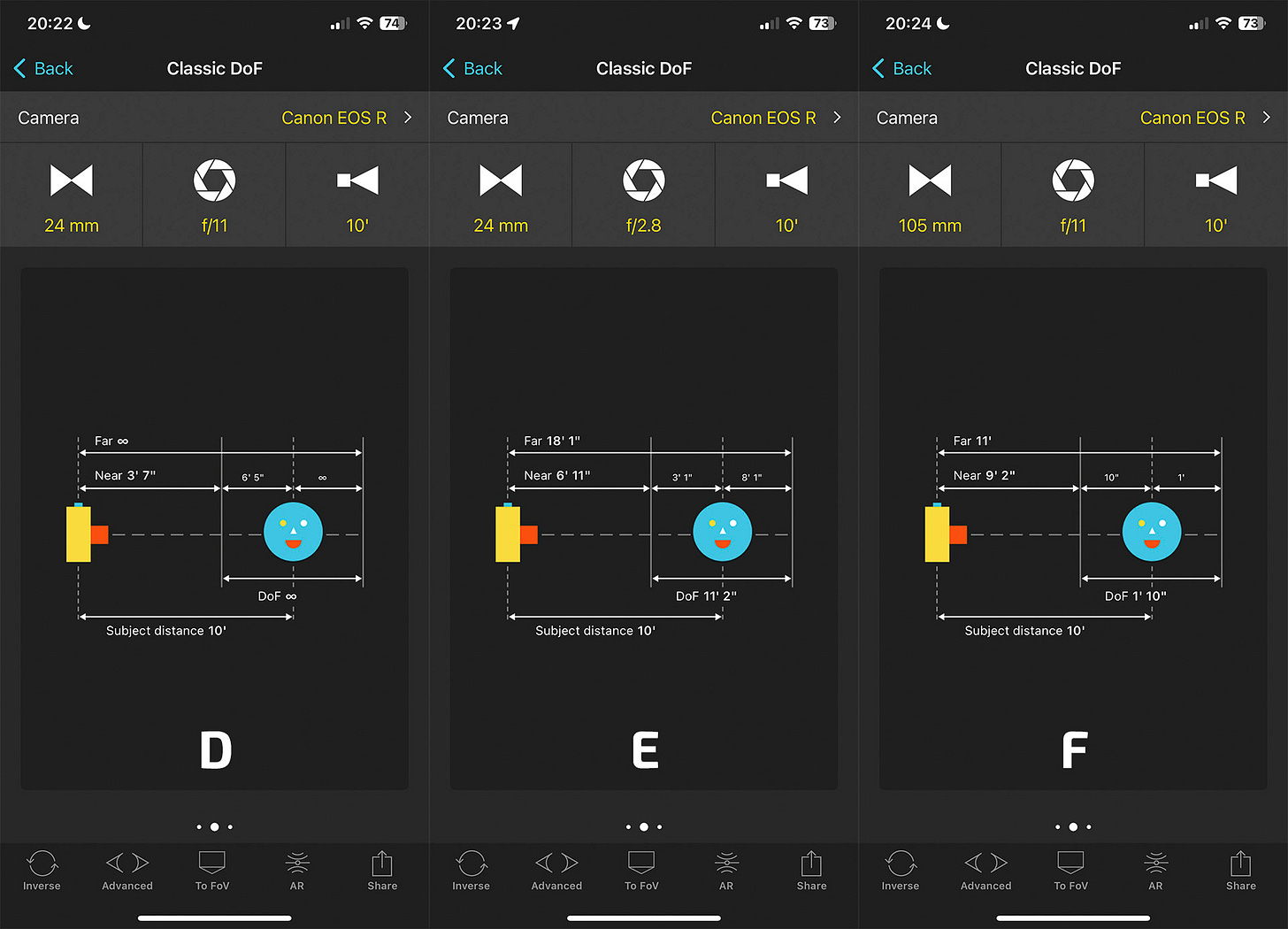
Look at screens E and F to compare what happens if I change my aperture or focal length.
By changing my lens aperture to f/2.8 (from f/11) (see screen E), I now have only 3 feet 1 inch of focus in front of my subject and 8 feet 1 inch behind it.
By changing my lens focal length to 105mm (from 24mm) (see screen F), I now have only 10 inches of focus in front of my subject and 1 foot behind it.
I will use screen B when I have a scene that I want to photograph where I want just a portion of the scene in focus, and that focus does not have to extend all the way to infinity. An example is the image (above) of the Ocotillos in Joshua Tree National Park (shot at f/4 @ 200mm). In this image, I wanted the subject to be the Ocotillo in the midground, and that's where I focused. With these lens settings, the foreground Ocotillo is out of focus, as is Pinto Mountain in the background.
Screen C shows you the hyperfocal distance for the scene that you're shooting with the selected settings. The hyperfocal distance is the distance that you must position your camera away from your subject such that everything from half the hyperfocal distance (i.e. halfway between your camera and subject) all the way to inifinity is in focus.
I will use screen C when I want to ensure that everything from just in front of my subject backward (i.e., to infinity) is in focus.
There will be scenes that you want to photograph where you cannot achieve the depth of field you want in a single shot. For example, when you're very close (less than 12 inches) to a subject (such as a barrel cactus), and you also have a distant mountain/hill in the background. If you try to take a single image, you can either have the cactus in focus or the mountain/hill, not both.
In this case, you would need to focus stack your image. This technique involves taking multiple images of the same scene, changing where you focus in each image. You then stack the images in post-processing to combine them into a single image with increased depth of field. This is a topic for a future post.
Let me be your landscape photography guide to Joshua Tree National Park
My workshops cater to all levels of photographers and include classic viewpoints and hidden gems. I'll ensure you're in the best place to take advantage of the light and weather conditions.
You can choose a one-to-one workshop (and personalize it to what you'd like to photograph, specific techniques, or how far you want to hike) or join a small group workshop (limited to 3 photographers).
Here are a few of my posts that you might be interested in reading:
Interesting musings, images, and art from others:
Gummi Bear Pizza? by Norm Rockwell
A Brief, Unsparingly Honest Guide To The Real British Countryside From Someone Who Knows by Tom Cox
Yorkshire, God's own country by Andrew Eberlin
A Re-Collection of Birds by Susanne Helmert
What Retirement Looks Like across the World by The Raw Society Stories
A Dance between Light and Shadow by Michela Griffith
This Election Year’s Top Three False Border and Immigration Narratives: A Q&A with David Bier by Todd Miller
Don't Go Chasing Fake Waterfalls by Casey Schreiner
My Sweet Midwest by Andy Adams
The ebbs are just as important as the flows by Robin Cangie



